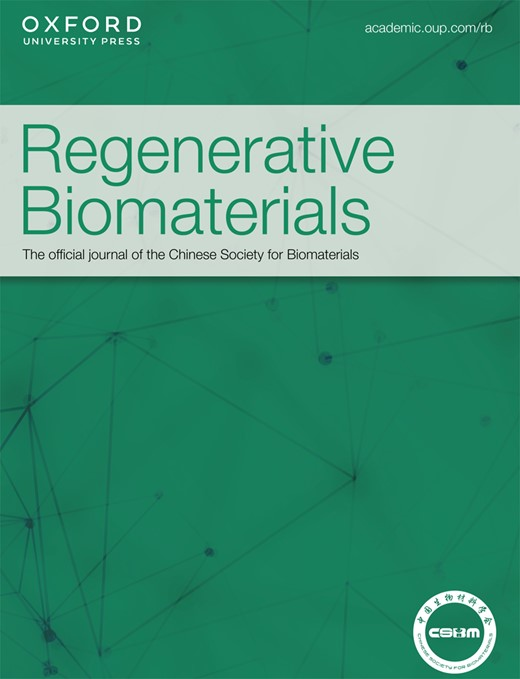3D printing sequentially strengthening high-strength natural polymer hydrogel bilayer scaffold for cornea regeneration
IF 5.6
1区 医学
Q1 MATERIALS SCIENCE, BIOMATERIALS
引用次数: 0
Abstract
3D printing of high-strength natural polymer biodegradable hydrogel scaffolds simultaneously resembling the biomechanics of corneal tissue and facilitating tissue regeneration remains a huge challenge due to the inherent brittleness of natural polymer hydrogels and the demanding requirements of printing. Herein, concentrated aqueous solutions of gelatin and carbohydrazide modified alginate (Gel/Alg-CDH) are blended to form a natural polymer hydrogel ink, where the hydrazides in Alg-CDH are found to form strong hydrogen-bonds with the gelatin. The hydrogen-bonding-strengthened Gel/Alg-CDH hydrogel demonstrates an appropriate thickened viscosity and shear-thinning for extrusion printing. The strong hydrogen bonds contribute to remarkably increased mechanical properties of Gel/Alg-CDH hydrogel with a maximum elongation of over 400%. In addition, sequentially Ca2+-physical crosslinking and then moderately chemical crosslinking significantly enhance the mechanical properties of Gel/Alg-CDH hydrogels that ultimately exhibit an intriguing J-shaped stress-strain curve (tensile strength of 1.068 MPa and the toughness of 677.6 kJ/m2). The dually crosslinked Gel-Alg-CDH-Ca2+-EDC hydrogels demonstrate a high transparency, physiological swelling stability and rapid enzymatic degradability, as well as suturability. Growth factor and drug-loaded biomimetic bilayer hydrogel scaffold is customized via a multi-nozzle printing system. This bioactive bilayer hydrogel scaffold considerably promotes regeneration of corneal epithelium and stroma, and inhibits cornea scarring in rabbit cornea keratoplasty.用于角膜再生的三维打印顺序强化高强度天然聚合物水凝胶双层支架
由于天然聚合物水凝胶固有的脆性和打印的苛刻要求,三维打印高强度天然聚合物可生物降解水凝胶支架同时具有类似角膜组织的生物力学和促进组织再生的功能仍然是一个巨大的挑战。在本文中,明胶和肼基改性海藻酸盐(Gel/Alg-CDH)的浓缩水溶液混合形成天然聚合物水凝胶墨水,发现 Alg-CDH 中的肼基与明胶形成强氢键。氢键加强型凝胶/Alg-CDH 水凝胶具有适当的增稠粘度和剪切稀化度,可用于挤出印刷。强氢键使 Gel/Alg-CDH 水凝胶的机械性能显著提高,最大伸长率超过 400%。此外,依次进行 Ca2+ 物理交联和适度化学交联可显著提高 Gel/Alg-CDH 水凝胶的机械性能,最终呈现出引人入胜的 J 型应力-应变曲线(拉伸强度为 1.068 兆帕,韧性为 677.6 kJ/m2)。双交联 Gel-Alg-CDH-Ca2+-EDC 水凝胶具有高透明度、生理溶胀稳定性、快速酶降解性和缝合性。生长因子和药物负载的生物仿生双层水凝胶支架是通过多喷嘴打印系统定制的。这种生物活性双层水凝胶支架能显著促进兔角膜上皮和基质的再生,并能抑制角膜角膜成形术中角膜瘢痕的形成。
本文章由计算机程序翻译,如有差异,请以英文原文为准。
求助全文
约1分钟内获得全文
求助全文
来源期刊

Regenerative Biomaterials
Materials Science-Biomaterials
CiteScore
7.90
自引率
16.40%
发文量
92
审稿时长
10 weeks
期刊介绍:
Regenerative Biomaterials is an international, interdisciplinary, peer-reviewed journal publishing the latest advances in biomaterials and regenerative medicine. The journal provides a forum for the publication of original research papers, reviews, clinical case reports, and commentaries on the topics relevant to the development of advanced regenerative biomaterials concerning novel regenerative technologies and therapeutic approaches for the regeneration and repair of damaged tissues and organs. The interactions of biomaterials with cells and tissue, especially with stem cells, will be of particular focus.
 求助内容:
求助内容: 应助结果提醒方式:
应助结果提醒方式:


